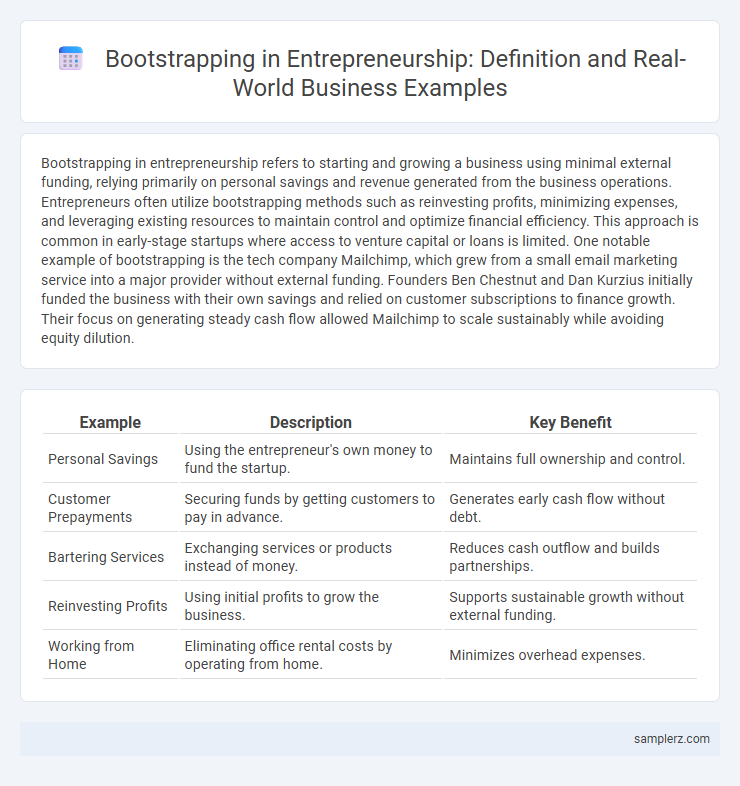Bootstrapping in entrepreneurship refers to starting and growing a business using minimal external funding, relying primarily on personal savings and revenue generated from the business operations. Entrepreneurs often utilize bootstrapping methods such as reinvesting profits, minimizing expenses, and leveraging existing resources to maintain control and optimize financial efficiency. This approach is common in early-stage startups where access to venture capital or loans is limited. One notable example of bootstrapping is the tech company Mailchimp, which grew from a small email marketing service into a major provider without external funding. Founders Ben Chestnut and Dan Kurzius initially funded the business with their own savings and relied on customer subscriptions to finance growth. Their focus on generating steady cash flow allowed Mailchimp to scale sustainably while avoiding equity dilution.
Table of Comparison
| Example | Description | Key Benefit |
|---|---|---|
| Personal Savings | Using the entrepreneur's own money to fund the startup. | Maintains full ownership and control. |
| Customer Prepayments | Securing funds by getting customers to pay in advance. | Generates early cash flow without debt. |
| Bartering Services | Exchanging services or products instead of money. | Reduces cash outflow and builds partnerships. |
| Reinvesting Profits | Using initial profits to grow the business. | Supports sustainable growth without external funding. |
| Working from Home | Eliminating office rental costs by operating from home. | Minimizes overhead expenses. |
Bootstrapping Defined in Entrepreneurship
Bootstrapping in entrepreneurship refers to the process where business founders start and grow their companies using personal savings, revenue generated from early sales, and minimal external funding. Entrepreneurs often rely on cost-saving strategies such as reinvesting profits, leveraging free digital tools, and negotiating extended payment terms with suppliers to maintain cash flow. This self-sufficient approach allows startups to retain full ownership and control while gradually building market presence.
Key Principles of Bootstrapped Startups
Bootstrapped startups prioritize lean operations by minimizing expenses and focusing on generating early revenue to sustain growth without external funding. Founders emphasize strong cash flow management, customer-centric product development, and iterative improvement to optimize resources efficiently. This approach fosters agility and resilience, allowing startups to maintain control and align closely with market demands.
Iconic Bootstrapping Success Stories
Iconic bootstrapping success stories include companies like Apple, which started in a garage using personal savings and minimal external funding, and Mailchimp, founded without venture capital but grew to a billion-dollar business through reinvested profits. These entrepreneurs leveraged limited resources by prioritizing customer feedback and iterative product development. Their journeys highlight how strategic resource management and innovation can drive substantial growth without relying on external investors.
Innovative Marketing Through Bootstrapping
Innovative marketing through bootstrapping in entrepreneurship often involves leveraging low-cost digital channels such as social media, content marketing, and email campaigns to build brand awareness without substantial funding. Entrepreneurs utilize customer feedback and guerrilla marketing tactics to create authentic engagement and grassroots growth. This approach maximizes limited resources while fostering creativity and direct connection with the target audience.
Cost-Cutting Strategies for Bootstrapped Businesses
Bootstrapped businesses often implement cost-cutting strategies such as leveraging free or low-cost digital marketing tools, utilizing coworking spaces instead of expensive office leases, and outsourcing tasks to freelancers rather than hiring full-time staff. Founders focus on minimizing operational expenses by negotiating favorable terms with suppliers and prioritizing essential expenditures that directly contribute to revenue generation. These practices enable startups to maintain financial control and extend their runway without external funding.
Lean Product Development from Bootstrapped Founders
Bootstrapped founders often leverage Lean Product Development to efficiently validate ideas and minimize costs by rapidly prototyping and gathering customer feedback. This approach enables entrepreneurs to conserve capital while iterating on product features based on real user data, avoiding costly assumptions and wasted resources. Successful examples include startups that prioritize minimum viable products (MVPs) to accelerate time-to-market and drive sustainable growth without external funding.
Funding Operations without External Investors
Funding operations through bootstrapping involves utilizing personal savings, reinvesting early revenues, and minimizing expenses to maintain control and avoid external debt. Entrepreneurs prioritize cash flow management and leverage customer payments to fund growth organically. This approach enables sustainable scaling without reliance on venture capital or angel investors.
Case Study: Bootstrapping in Tech Startups
Tech startups frequently employ bootstrapping by leveraging founder savings, early customer revenues, and minimal external funding to maintain control and reduce financial risk. A notable example includes Mailchimp, which grew its email marketing platform to a billion-dollar valuation without venture capital by reinvesting profits and focusing on organic growth. This approach enables startups to prioritize sustainable development while preserving equity and decision-making power.
Overcoming Challenges in Bootstrapped Ventures
Bootstrapped ventures often overcome financial constraints through innovative resource management and strategic prioritization of core business activities. Entrepreneurs leverage personal savings, pre-sales, and organic growth tactics to sustain operations without external funding, minimizing debt and dilution. Focused problem-solving and agile decision-making empower these businesses to adapt quickly, ensuring resilience amid market uncertainties and limited capital.
Essential Tools for Bootstrapped Entrepreneurs
Bootstrapped entrepreneurs often rely on essential tools such as cloud-based accounting software like QuickBooks, project management platforms like Trello, and marketing automation tools like Mailchimp to streamline operations and reduce costs. Utilizing free or low-cost resources such as Google Workspace for collaboration and Canva for graphic design enables startups to maintain professional standards without significant upfront investment. These tools support efficient resource allocation, enabling founders to focus on growth while preserving limited financial resources.

example of bootstrapping in entrepreneurship Infographic
 samplerz.com
samplerz.com